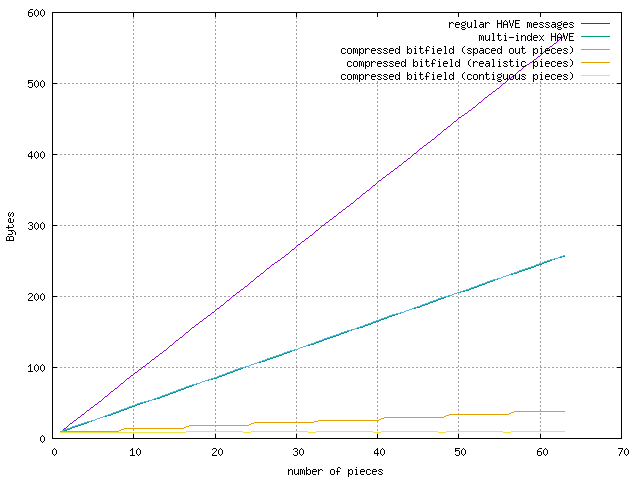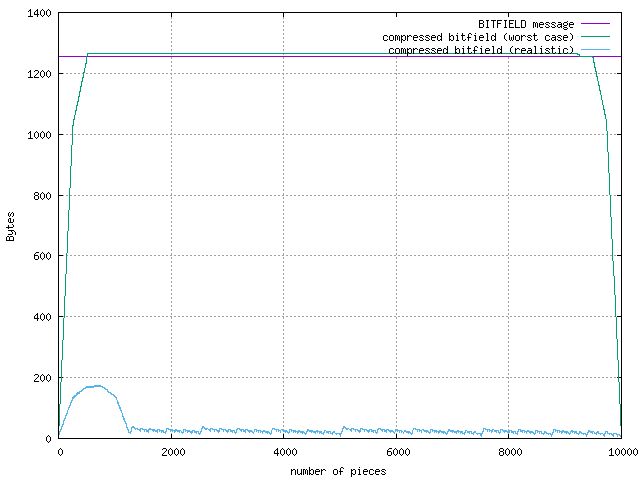- BEP
46
- Title
Have message for multiple pieces
- Version
$Revision$ - Last-Modified
$Date$ - Author
Arvid Norberg <arvid@libtorrent.org>
- Status
Draft
- Type
Standards Track
- Content-Type
text/x-rst
- Created
26-May-2016
- Post-History
This BEP proposes an extension that aims to significantly reduce the overhead of torrents with many pieces, by making representations more compact and enabling coalescing of HAVE messages.
Small pieces have significant benefits. They enable:
- Shorter delays from downloading data until it can be reliably consumed (important for streaming)
- Shorter delays forwarding downloaded bytes to other peers. This is most obvious when first joining a swarm, but also significant in swarms bottlenecked by its seeds
Pieces should be small, ideally 16 kiB. The costs associated with small pieces are:
- the size of the .torrent file. Each piece hash is 20 bytes. a 4GiB torrent with 16 kiB pieces would have a .torrent file greater than 5 MB.
- The size of bitfield messages. Every peer that has some but not all pieces send a bitfield during peer handshake. With this hypothetical 4 GiB torrent, each bitfield message would be 32 kiB (equivalent to two payload blocks).
- The number of HAVE messages that would need to be sent to peers during downloads would be a lot higher. Each HAVE message is 9 bytes (length prefix, type and piece index) and possibly another 20 bytes if sent on an otherwise idle connection (TCP/IP overhead). Compared to the same torrent with a piece size common today (2 MiB), it would require 128 times as many messages.
- The number of request messages that would need to be sent per byte of payload byte received.
Issue (1) is addressed by merkle tree torrents, in BEP30.
This BEP attempts to address (2) and (3).
This BEP proposes a new extension message which announces multiple pieces in a single message in a space-efficient manner. The content of the message is conceptually an entire bitfield with bits set for the new pieces the peer has received.
Extension handshake message name is "lt_have".
This message can be used to substitute the BITFIELD and HVAE messages.
The bitfield is not transferred verbatim, it is run length encoded, as a sequence of commands. Each command is encoded as a byte aligned block. The first bit of each block, i.e. the most significant bit of the first byte, indicates whether the block is a fill- or verbatim block. The next bit indicate which bit to fill, for fill blocks.
These are the commands:
- fill forward n bytes of zeroes (0x00)
- fill forward n bytes of ones (0xff)
- consume the next n bytes as verbatim bits of the bitfield
- fill forward n bytes of zeroes and consume one byte of verbatim bitfield
The start position is always at the first piece in the torrent, position 0. All commands progress the cursor forward, towards higher piece indices.
The num_bytes field in all command blocks are unsigned and big-endian.
Since there is no point in ever encoding 0 bytes in the num_bytes field, the number of bytes referred to is always num_bytes + 1. i.e. if the num_bytes field is 0, it means to fill 1 byte or a single verbatim byte.
If the message ends before reaching the last piece, the remaining bits are assumed to be zero.
A block may run past the last piece position by at most 7 bits. This is required since all blocks are byte aligned. A run that extends past the last piece by more than 7 bits should be considered a malformed message.
|0 |8 | 16
+-+-+-+-+-+-+-+-+-+-+-+-+-+-+-+-+
|0|0| num_bytes (14 bits) |
+-+-+-+-+-+-+-+-+-+-+-+-+-+-+-+-+The first bit is 0 = fill block. The next bit is 0 = fill with zeros. The next 14 bits encode the number of bytes of bitfield this zero-run is. The number of bytes is num_bytes + 1.
|0 |8 | 16
+-+-+-+-+-+-+-+-+-+-+-+-+-+-+-+-+
|0|1| num_bytes (14 bits) |
+-+-+-+-+-+-+-+-+-+-+-+-+-+-+-+-+The first bit is 0 = fill block. The next bit is 1 = fill with ones. The next 14 bits encode the number of bytes of bitfield this fille-run is. The number of bytes is num_bytes + 1.
|0 |8
+-+-+-+-+-+-+-+-+
|1| num_bytes |
| | (7 bits) |
+-+-+-+-+-+-+-+-+The first bit is 1 to indicate a verbatim block. The next 7 bits are the num_bytes field. The number of bytes following this command to be interpreted as verbatim bits is num_bytes + 1.
The following block decodes into 11 bytes of zeroes. Command is 0 (fill), fill value is 0 (fill zeros) num_bytes is 10, +1 makes it a run of 11 bytes (hex):
00 0A => 00 00 00 00 00 00 00 00 00 00 00The following block decodes into 5 bytes of ones. Command is 0 (fill), fill value is 1 (fill ones) num_bytes is 4, +1 is a run of 5 bytes (hex):
40 04 => FF FF FF FF FFThe following block decodes into 4 bytes of verbatim bitfield. Command is 1 (verbatim block). num_bytes is 3, +1 is a run of 4 bytes (hex):
83 BA AD F0 0D => BA AD F0 0DThe following block decodes into 10 bytes of zeros, followed by two bits set. The first command is 0 (fill), fill value 0 (fill zeros) and num_bytes is 9 (10 bytes to fill). The second command is 1 (verbatim block), num_bytes 0 (1 byte) followed by the one verbatimg byte:
09 80 C0 => 00 00 00 00 00 00 00 00 00 00 C0Message sizes for single messages are comparable to regular HAVE messages for piece indices <= 131072 (there's one extra byte for the extension message).
| piece | regular HAVE msg (+ length prefix) | compressed bitfield (+ length prefix) |
|---|---|---|
| 100 | 04 00 00 00 64 = 9 bytes | 14 xx 00 0B 80 08 = 10 bytes |
| 3100 | 04 00 00 0C 1C = 9 bytes | 14 xx 01 82 80 08 = 10 bytes |
| 57200 | 04 00 00 DF 70 = 9 bytes | 14 xx 1B ED 80 80 = 10 bytes |
| 131074 | 04 00 02 00 02 = 9 bytes | 14 xx 3F FF 80 20 = 10 bytes |
| 140003 | 04 00 02 22 E3 = 9 bytes | 14 xx 3F FF 04 5B 80 10 = 12 bytes |
For multiple pieces, the ability to coalesce them into a single message provides some savings.
| piece | regular HAVE msg (+ length prefix) | compressed bitfield (+ length prefix) |
|---|---|---|
| 100,101 | 18 bytes | 14 xx 00 0B 80 0C = 10 bytes |
| 3100,5601 | 18 bytes | 14 xx 01 82 80 08 01 37 80 40 = 14 bytes |
| 1,57200 | 18 bytes | 14 xx 80 40 1B EC 80 80 = 12 bytes |
| 131074,131075 | 18 bytes | 14 xx 3F FF 80 30 = 10 bytes |
| 2,140003 | 18 bytes | 14 xx 80 20 3F ff 04 5A 80 10 = 14 bytes |
The plot below compares the transfer size requirements of sending multiple HAVE messages, to a hypothetical HAVE message that can have multiple piece indices and the compressed bitfield message.
The compressed bitfield message size can vary a lot based on the pieces to encode. The plot below provides three samples of the compressed bitfield message.
- where pieces are spread out as far away from each other as possible. This provide an upper bound of message sizes.
- where pieces are entirely contiguous, sequential download. This provides a lower bound of the message sizes.
- A more realistic distribution of pieces, where 8 pieces at a time are clustered together, but where the clusters themselves are spaced as far apart as possible
This is a torrent with 10000 pieces.
The regular have message has a 4 byte length prefix, 1 byte message type and a 4 byte piece index. The hypothetical HAVE message is one where there can be an arbitrary number of piece indices in a message. This is used as a benchmark since it would be a much simpler way of optimizing bandwidth usage of HAVE messages.
The graph above shows that the worst case compressed bitfield is on-par with this hypothetical multi-HAVE message.
The worst case compressed bitfield is one where there are no 16 consecutive zeros or ones. In these cases the entire bitfield has to be encoded as verbatim blocks.
Assuming the same 10000 piece-torrent, a BITFIELD message would be:
1255 Bytes
The same message encoded as a compressed bitfield would incur the one byte overhead every 128 bytes, making it 9 bytes larger:
1264 Bytes
The below plot shows messages sizes for the worst case bitfields, over number of pieces in it.
A python reference implementation of encoding and decoding compressed bitfields is available on github at: https://github.com/arvidn/bittorrent-multi-have
This document has been placed in the public domain.

